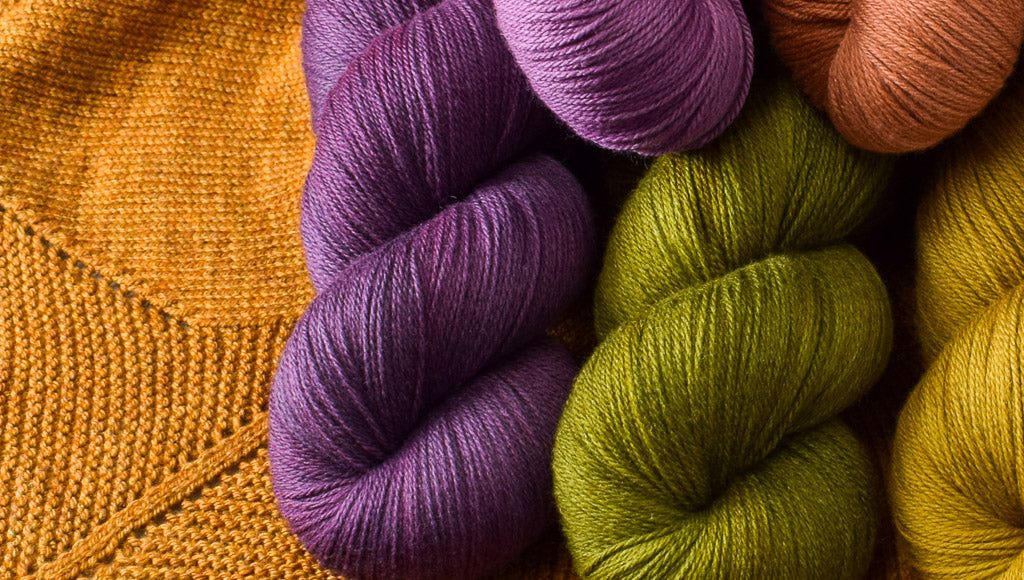We love Killington for so many reasons and are excited to share more about it in depth this month. Killington is a lofty DK weight blend of non-superwash Polwarth wool and Tussah silk in a generous 700-yard skein. This yarn has great bounce and elasticity from the wool, plus a beautiful sheen from the silk.
So, first, what's Polwarth wool? The Polwarth sheep is a hybrid of Merino and Lincoln breeds and was developed in Australia in the 1880s as a dual-purpose sheep (reared for both meat and wool). Polwarth sheep were exported to New Zealand in the early 1930s, and that's where most of this wool comes from.
Polwarth fiber has many desirable qualities. Its fleece is known for having the softness and low micron fiber count of its Merino ancestors, but the strength of its Lincoln line. It has a long staple length which makes a strong, smooth and silky yarn with good stitch definition. As an ultra-white fiber, it takes color with clarity and depth. Moreover, its relatively low micron count (23-25) means you can wear it next to the skin, but at the same time, it's not so soft as to be prone to pilling.
One of the features we love most about Killington is stitch definition; the yarn's unique blend of long-staple Polwarth and silk fibers means that each and every stitch you knit will stand out. That characteristic bodes well for projects with a lot of texture--as you can see here in these three sweater projects.

The Beekeeper Cardigan, designed by Marie Greene and shown here in Old Gold, is an all-over small textured patterned cardigan without closures. In a fuzzier yarn, these textured stitches would blend into the background, but in Killington, they just pop! (As an aside, choosing a lighter colorway when knitting texture also helps the patterning stand out; you may dream of the Beekeeper in black, but no one will actually see all the work you put into it)!

Two other sweaters, Carrick Bend by Amanda Scheuzger (shown above in Moss) and Morning Tea Cardigan by Laura Chau (shown below in Caramel), incorporate cabled panels, instead of an all-over stitch design. The purl stitches that separate the stockinette body from the cabled panels again make the cables really pop from the stockinette background.

There's an added bonus to knitting textured sweaters in a DK weight yarn like Killington. The raised stitches don't add unwanted bulk to your garment (or your body), but they do also trap air, making them warm enough for winter, but lightweight enough for spring and fall.
We encourage you to try a sweater with Killington. We think you'll love how it feels in your hand, how it knits up, and how it wears; it's a great sweater yarn and you'll be thrilled with the results. In addition to these three examples, we've identified some other sweater projects that would look great in Killington in this Ravelry bundle.

The same positives of stitch definition and loftiness hold true for shawls and accessories. Whether the project incorporates an all-over textured pattern, like Rust Never Sleeps by Leila Raven (shown above in Paprika), or a cabled panel, like Gwytherin by Amanda Scheuzger (shown below in Herbalist), Killington's fiber structure gives those textures some extra pop! And a 700-yard skein goes a LONG way, letting you create a big shawl or wrap with just one skein.

We also love Killington for how it takes dye. The long-staple Polwarth absorbs dye with clarity and depth, and the Tussah silk adds just a hint of luster, making it an excellent canvas for both monochromatic and variegated colorways.

Just look at Melissa LaBarre's Elm Blanket (shown here in Old Gold and Cordovan) for proof--the textured garter stitch and yarn-over patterning play hand in hand with the depth of color you get from the stockinette leaf sections. Killington turns this relatively simple knit into a stunning piece.

Non-superwash wools also block out beautifully for lace patterns. Here is Ewelina Murach's Rib and Lace Shawl (shown in Celtic). The yarn overs open up and hold blocking well, while the yarn has enough structure to maintain its texture.
For more Killington accessory pattern suggestions, we've created a bundle on Ravelry. You can also see more projects designed in Killington in our Project Gallery.

